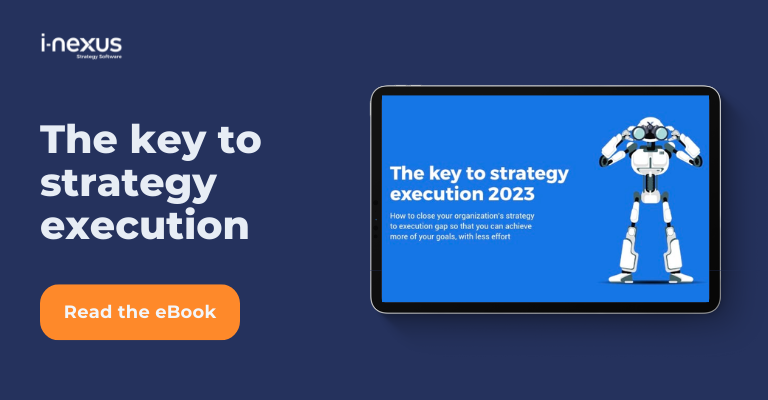Learn the five best practices you can put into practice for strategy execution management in our how-to guide.
Effective strategy execution is the linchpin of turning your business aspirations into tangible success.
You need more than having a well-crafted strategic plan; you need the best practices to execute it efficiently.
In this blog, we delve into best practices in strategy execution management.
From ensuring alignment to the importance of strong leadership across the organization, here are the five best practices you should put to practice in your efforts.
If you've not had a chance to read our first part of the series, you can do so below:
What's the importance of best practices in strategy execution?
Starting with the fundamentals, it's vital to understand the significance of best practices in strategy execution management.
These best practices serve as the guiding principles that lead organizations toward achieving their strategic objectives.
They provide a roadmap to success, ensuring that your strategic vision doesn't remain a lofty ideal but becomes a tangible reality.
Effective strategy execution is a flywheel that never ends - it's a multi-faceted journey that requires careful planning, seamless alignment, and ongoing monitoring.
Every step in this journey demands a different set of skills and tools.
The role of best practices is to guide you through these steps and provide the wisdom accumulated from successful executions.
In exploring best practices, we aim to cover the full spectrum of strategy execution. When applied meticulously, each practice contributes to the overarching goal of turning strategy into results.
So, let's begin.
1. Define clear Objectives and Key Results (OKRs)
Clear objectives for targeted success
It doesn't necessarily have to be an OKR framework but it is a great starting point.
Setting clear and measurable objectives is the bedrock of strategy execution. These objectives, often encapsulated as Key Results (KRs) within the OKR framework, help you track your progress toward achieving your strategic goals.
In the context of best practices, it's not just about setting objectives; it's about setting the right objectives.
A critical best practice is ensuring these objectives are specific, measurable, achievable, relevant, and time-bound (SMART).
Adhering to the SMART criteria ensures your objectives are well-defined and provide a clear path to success.
Example: Google's Transformation with OKRs
Google famously adopted the OKR framework early in its history.
This helped the tech giant set ambitious yet attainable goals, such as improving the quality of search results. Google enhanced its search algorithm by aligning teams around these objectives, resulting in more relevant and reliable search results.
But setting clear objectives is just the beginning.
Ensuring the entire organization understands and aligns with these objectives is equally important.
Communication and transparency are key components of this practice. Regularly sharing the objectives with all stakeholders and providing updates on progress help keep everyone on the same page.
Effective objective setting involves cascading the objectives throughout the organization, ensuring that every team, department, and individual understands how their work contributes to the larger strategy.
Employees knowing how their efforts link to the organization's objectives fosters a sense of purpose and unity.
2. Use a Balanced Scorecard Framework
Balancing act for strategic excellence
The Balanced Scorecard framework is a powerful tool that facilitates strategy execution.
It transcends financial metrics to embrace multiple aspects of performance.
The Balanced Scorecard ensures comprehensive alignment by translating your strategy into specific objectives, metrics, targets, and initiatives across four key areas - financial, customer, internal processes, and learning and growth.
Example: Pioneering with the Balanced Scorecard at Ford
Ford Motor Company effectively used the Balanced Scorecard to align its strategic vision. By focusing on metrics such as customer satisfaction, defect reduction, and cycle time, Ford transformed its processes and improved customer experiences, leading to sustainable growth and profitability.
But, it's important to remember that best practices are broader than defining objectives and implementing frameworks.
Innovation and adaptability play a pivotal role in the execution of a strategy. Innovation isn't just about groundbreaking products or technologies; it extends to innovative approaches in every aspect of your business. Apple shows that.
Example: Apple's Innovation Journey
Apple has consistently exhibited innovation and adaptability in its strategy execution. From groundbreaking product launches to manufacturing and supply chain management adjustments, Apple's ability to pivot and innovate has ensured its continued success and brand loyalty.
Learn more about the different tools and frameworks for strategy execution management in our eBook:
3. Track and act on strategic risks
Managing risks for robust execution
No strategy is without risks; tracking and acting upon them is essential.
These risks can be internal, stemming from factors within your organization, and external, originating from market forces, competition, or other external variables.
Effective risk management practices:
- Identifying potential risks
The first step in managing strategic risks is identifying them. This involves systematically examining the various components of your strategy and organization to pinpoint possible risks.
These risks range from operational inefficiencies and resource constraints to market volatility and regulatory changes. - Assessing impact
Once identified, it's crucial to assess the potential impact of these risks on your strategic objectives.
This involves evaluating how a specific risk can impede or enhance your strategic goals. By understanding the possible consequences, organizations can prioritize and prepare accordingly. - Developing mitigation strategies
The core of risk management lies in developing strategies to mitigate or address identified risks.
Organizations create contingency plans, set up risk mitigation teams, and allocate resources to reduce the likelihood and impact of potential risks. It's about being proactive in dealing with challenges.
Example: Risk management at Boeing
Boeing is well-known for its rigorous approach to risk management in executing its strategies.
Given the complexities of the aviation industry, they have always faced internal challenges like production quality and external risks such as market volatility and geopolitical factors.
- Risk identification
Boeing systematically identifies potential risks across its value chain. This includes risks related to aircraft production, supply chain disruptions, and changing market demands. They maintain a comprehensive list of risks that could affect their strategic objectives. - Impact assessment
Once identified, Boeing assesses the impact of these risks. They evaluate how each risk could affect their production timelines, cost structures, and market positioning. This assessment helps them understand which risks need immediate attention. - Mitigation strategies
Boeing's approach to risk management includes developing comprehensive mitigation strategies. For instance, they diversify their supplier base to minimize the impact of supply chain disruptions. They also allocate resources to research and development, allowing them to advance in technological advancements.
Boeing's dedication to risk management is evident in its consistent execution of strategic plans. By actively identifying, assessing, and addressing these risks, they have maintained their position as a leader in the aerospace industry.
Taking control of uncertainties
Effectively managing risks is about taking control of uncertainties. By doing so, organizations ensure they are prepared for unexpected challenges and can pivot when necessary.
Risk management is not about eliminating all risks; it's about making strategic choices that minimize the potential harm and maximize opportunities.
In a world of constant change, it's a practice that ensures robust execution and long-term success.
4. Aligning Vision, Mission, and Values to strategic goals
Harmonizing purpose and strategy
For strategy execution to be truly effective, aligning the organization's vision, mission, and values with the strategic goals is essential.
These foundational elements provide a sense of purpose and direction, shaping the organization's culture and decision-making.
It's about ensuring the organization's heart beats with its strategic path.
The importance of aligning Vision, Mission, and Values:
- Clarity and consistency
When your purpose aligns with your strategic goals, they are guiding principles. They clarify the "why" behind your strategy, ensuring everyone understands the larger purpose.
This clarity translates into consistency in decision-making, as actions are evaluated against the organization's core beliefs and objectives. - Cultural harmony
Aligning vision, mission, values, and strategic goals fosters cultural harmony. It promotes a work environment where everyone shares a common vision, vital for motivation and employee engagement. - Enhanced stakeholder buy-in
When stakeholders, including employees, customers, and partners, see that an organization's strategy aligns with its stated mission and values, they are more likely to buy into and support it. This alignment enhances trust and credibility. - Resilience in change
Organizations often face changes and challenges in their journey toward executing their strategy. Having a robust alignment between foundational principles and strategy provides resilience. It helps the organization stay true to its core beliefs while adapting its strategy to changing circumstances. - Attracting talent
A precise and well-communicated alignment of vision, mission, and values with strategic goals can be a powerful tool for attracting top talent. Individuals who share your organization's vision and values are more likely to be attracted to your workplace, contributing to a culture of like-minded individuals.
5. Leaders can bring strategy execution to life
Successful strategy execution relies on the active participation of leaders across the organizational hierarchy:
1. C-suite leadership
- Setting the tone
The C-suite leadership, including the CEO, sets the tone for strategy execution. They define the vision, mission, and values and align them with the strategic goals. They are responsible for creating a culture of execution excellence. - Resource allocation
C-suite leaders allocate the necessary resources to support the strategy. This includes budgeting, personnel, and technology investments, ensuring the strategy is adequately resourced for success. - Risk management
They play a pivotal role in identifying and addressing risks. By taking a proactive approach to risk management, they safeguard the strategy's success.
2. Middle management
- Communication and alignment
Middle managers are the crucial bridge between the C-suite and the shop floor. They convey the strategic objectives to their teams, ensuring every member understands their role in achieving them. - Feedback loop
Middle managers provide valuable insights to senior leadership about how the strategy is being received and implemented at the ground level. This feedback is vital for making necessary adjustments. - Conflict resolution
When conflicts or resistance arise, middle managers can help resolve these issues as a bridge between front-line employees and senior leaders. - Empowerment
Middle managers should empower their teams to make decisions and take ownership of their contributions to the strategy.
3. Shop floor workers
- Execution and innovation
Front-line employees are where the rubber meets the road. They play a crucial role in executing the strategy. Moreover, they are often the source of innovation. Their input can lead to process improvements and innovative solutions. - Ownership and accountability
Just as leaders hold them accountable for executing the strategy, front-line workers must take ownership of their contributions. Ownership ensures that they actively work toward achieving the strategic objectives.
The combined effort of leadership at all levels brings strategy execution to life. While the C-suite sets the strategic direction, middle managers ensure it's translated effectively to the shop floor. At the same time, shop floor workers are the backbone of execution.
When everyone understands their role in achieving the strategic goals, and these roles align with the organization's vision, mission, and values, you create a synergy essential for successful execution.
This alignment generates a sense of purpose, unity, and shared responsibility, ultimately propelling the organization toward strategic success. Thus, leadership at all levels must promote this alignment, ensuring the organization works harmoniously to achieve the shared vision.
Putting the practice into best practice
By adhering to these best practices, organizations can bridge the gap between strategy and execution, fostering a culture of excellence that transforms vision into reality.
It's about combining strategic thinking with robust execution practices, making the impossible possible and inevitable.
The world's most successful organizations have repeatedly proven that the right practices can turn strategies into success stories.
It's time to write your own.
To see more about how you can lead your team, download our leadership eBook:
Read more about strategy execution and related tools with our content below:
- Key to strategy execution eBook: Read how companies like Danaher and HP have mastered strategy execution and what you can learn from them.
- What role does a Strategy Realization Office play in your strategy execution?: Learn how you can govern your strategy execution with the emerging concept of the Strategy Realization Office (SRO)
- 13 ways to make your team care about goals: Try these 13 ideas for getting your team to buy into your goals, and create real accountability for delivering targets.
About the author
James Milsom is Head of Marketing at i-nexus. As Head of Marketing, his drive is to raise awareness and understanding of the challenges facing enterprises in delivering strategic objectives and transformation amidst changing markets and the obstacles traditional tools and methods present leaders.
If you’d like to talk strategy, contact James at james.milsom@i-nexus.com or connect with him on LinkedIn for the latest insights.



